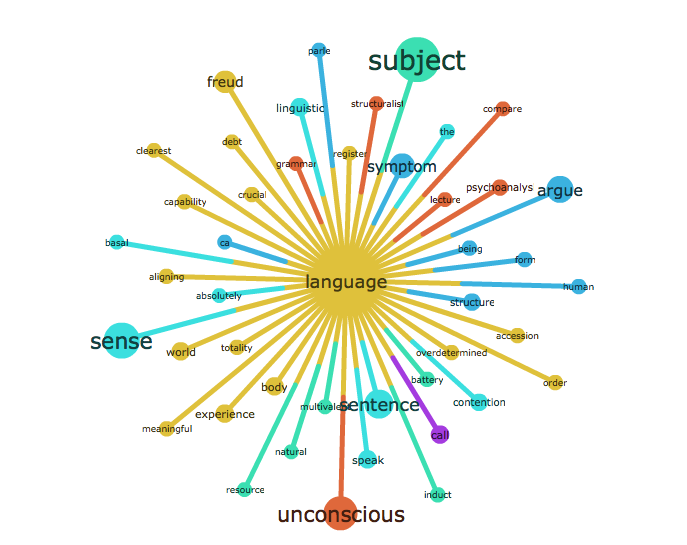Posted by Nodus Labs | January 10, 2012
Polysingularity of Text Expressions

Italo Calvino once said that “writing is essentially a combinatorial exercise” and that “reading is a way of exercising the potentialities contained in the system of signs” (Calvino 1985). Text, therefore, is not merely a sequence of words that produce a meaning. It’s an actualization of a certain possibilities within our cognitive dynamics, which have the intention of expressing themselves.
Using our method for text network analysis (Paranyushkin 2011a, 2011b), Alexis Jacomy’s GexfWalker and Gephi (Bastian et al 2009), we created graph visualizations of several seminal texts that allow you to explore their polysingularity. The words are the nodes and their proximity relates to the strength of connections between them. Thus, the original combinatorial structure of the text is inscribed into these graphs, but you exercise their polysingularity in many more ways than the standard sequential writing proposes. Think of it as a map of “strange attractors”, which are neither exact, nor permanent, but the temporary polysingular solutions that the non-linear dynamical system of text is drawn towards.
Note: please, wait 30 seconds until the graphs below load. To zoom in and out, use the mouse-wheel scroll, to navigate through the graph, click the word-node.
Bible, Genesis 1:1
Quran, Al Baqarah
Martin Luther King, “I Have a Dream”
Lewis Carroll, “Alice in Wonderland”
Explanatory note:
Radical embodied cognitive science explains language in terms of agent-environment dynamics (Chemero 2009; Johnson 2007). There is no representation, every expression is a manifestation of a dynamic process where certain elements come into relation to one another to produce the meaning. The existence of semantically related concepts can be explained through the emergence of so-called “strange attractors”, which are neither exact, nor permanent, but the temporary solutions that the non-linear dynamical system of text is drawn towards.
As a part of our research on polysingularity of text we created several network visualizations of popular texts: from the Bible and Quran to Alice in Wonderland and Martin Luther King’s speech. We use the approach where the text is first transformed into a sequence of morphemes, which are then mapped into a network based on their co-occurrences (Paranyushkin 2011a, 2011b), where the unique words (morphemes) are the nodes and their proximity to one another indicates the strength of connections between them. This method allows us to represent the clusters of meaning circulation or the “strange attractors” within the text. It indicates the traces of the pathways that the writer took in order to communicate the meaning, or to use Calvino’s terms – the combinations that are inscribed into the text’s corpus. It also offers a system of reading that proposes many more potentialities than the standard chronologically structured text. As a reader, you can start where you want and navigate through the text’s network randomly in order to create your own reading of it. However, as the original structure of the writing is inscribed into the network, even such random navigation will tend to gravitate towards the “strange attractors”, the islands of polysingularity that exist within the text.
We invite you to play with the different possibilities that our polysingular text player proposes and share with us how it affects your perception of the texts that you know already.
Contact us if you want us to represent your text in this way or get the original datasets used to visualize the texts above.
References:
Bastian, M.; Heymann, S.; Jacomy, M.; (2009). Gephi: An Open Source Software for Exploring and Manipulating Networks. Association for the Advancement of Artificial Intelligence.
Calvino, I (1986). The Uses of Literature. Orlando: A Harvest Book
Cheremo, A. (2009). Radical Embodied Cognitive Science. The MIT Press.
Johnson, M. (2007). The Meaning of the Body. The University of Chicago Press
Paranyushkin, D; (2011a). Identifying the Pathways for Meaning Circulation Using Text Network Analysis. Nodus Labs
Paranyushkin, D; (2011b). Visualization of Text’s Polysingularity Using Text Network Analysis. Nodus Labs

